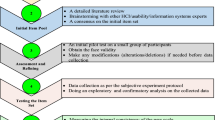Abstract
Voice user interfaces (VUIs) offer an intuitive, fast and convenient way for humans to interact with machines and computers. Yet, whether they’ll be truly successful and find widespread uptake in the near future depends on the user experience (UX) they offer. With this survey-based study (n = 108), we aim to identify the major annoyances German voice assistant users are facing in voice-driven human-computer interactions. The results of our questionnaire show that irritations appear in six categories: privacy issues, unwanted activation, comprehensibility, response quality, conversational design and voice characteristics. Our findings can help identify key areas of work to optimize voice user experience in order to achieve greater adaptation of the technology. In addition, they can provide valuable information for the further development and standardization of voice user experience (VUX) research.
Access this chapter
Tax calculation will be finalised at checkout
Purchases are for personal use only
Similar content being viewed by others
References
Seaborn, K., Urakami, J.: Measuring voice UX quantitatively. In: Kitamura, Y., Quigley, A., Isbister, K., Igarashi, T. (eds.) Extended Abstracts of the 2021 CHI Conference on Human Factors in Computing Systems, Article 416, pp. 1–8. Association for Computing Machinery, New York (2021). https://doi.org/10.1145/3411763.3451712
Juang, B.H., Rabiner, L.R.: Automatic speech recognition - a brief history of the technology development. In: Georgia Institute of Technology, Atlanta Rutgers University and the University of California, Santa Barbara (2004). https://web.ece.ucsb.edu/Faculty/Rabiner/ece259/Reprints/354_LALI-ASRHistory-final-10-8.pdf. Accessed 8 Feb 2022
Kahle, T., Meißner, D: All about voice. Konzeption, Design und Vermarktung von Anwendungen für digitale Sprachassistenten. Haufe Group, Freiburg (2020)
Klein, A.M., Hinderks, A., Schrepp, M., Thomaschewski, J.: Measuring user experience quality of voice assistants. In: 15th Iberian Conference on Information Systems and Technologies (CISTI), Sevilla, Spain, pp. 1–4. IEEE (2020). https://doi.org/10.23919/CISTI49556.2020.9140966
Thar, E.: Ich habe Sie leider nicht verstanden. Linguistische Optimierungsprinzipien fuer die muendliche Mensch-Maschine-Interaktion. Peter Lang, CH (2015)
Pearl, C.: Designing Voice User Interfaces. Principles of Conversational Experiences. O’Reilly, Beijing (2017)
Grice, H.P.: Logic and conversation. In: Cole, P., Morgan, J.L. (eds.) Syntax and Semantics, vol. 3, Speech Acts, pp. 41–58. Academic Press, New York (1975)
DIN EN ISO 9241-110:2020-10: Ergonomie der Mensch-System-Interaktion - Teil 110: Interaktionsprinzipien. Beuth Verlag, Berlin (2020)
Miclau, C., Demaeght, A., Müller, A.: Empirical research as a challenge in day-to-day teaching during the pandemic of 2020/21 - practical solutions. In: Nah, F.-H., Siau, K. (eds.) HCII 2021. LNCS, vol. 12783, pp. 608–618. Springer, Cham (2021). https://doi.org/10.1007/978-3-030-77750-0_40
Jo, M.Y., Stautmeister, A.: Don’t make me think aloud! – Lautes Denken mit Eye-Tracking auf dem Prüfstand. In: Brau, H., Lehmann, A., Petrovic, K., Schroeder, M.C. (eds.) Tagungsband UP11, pp. 172–177. German UPA e.V., Stuttgart (2011)
Gast, O.: User experience im e-commerce. Messung von Emotionen bei der Nutzung interaktiver Anwendungen. Springer, Cham (2018). https://doi.org/10.1007/978-3-658-22484-4
Ekman, P., Friesen, W.: Manual for the Facial Action Coding System. Consulting Psychologists Press, Palo Alto (1978)
Audeering Homepage. https://www.audeering.com/de/. Accessed 6 Feb 2022
LimeSurvey Homepage: LimeSurvey: An Open Source Survey Tool; LimeSurvey GmbH, Hamburg, Germany. https://www.limesurvey.org/de/. Accessed 6 Feb 2022
Dallmer-Zerbe, S., Haase, J.: Adapting smart home voice assistants to users’ privacy needs using a Raspberry-Pi based and self-adapting system. In: 2021 IEEE 30th International Symposium on Industrial Electronics (ISIE), pp. 1–6 (2021). https://doi.org/10.1109/ISIE45552.2021.9576469
Anniappa, D., Kim, Y.: Security and privacy issues with virtual private voice assistants. In: 2021 IEEE 11th Annual Computing and Communication Workshop and Conference (CCWC), pp. 0702–0708 (2021). https://doi.org/10.1109/CCWC51732.2021.9375964
Germanos, G., Kavallieros, D., Kolokotronis, N., Georgiou, N.: Privacy issues in voice assistant ecosystems. In: 2020 IEEE World Congress on Services (SERVICES), pp. 205–212 (2020). https://doi.org/10.1109/SERVICES48979.2020.00050
Sweeney, M., Davis, E.: Alexa, are you listening? In: Information Technology and Libraries 39(4) (2020). https://doi.org/10.6017/ital.v39i4.12363
Pal, D., Arpnikanondt, C., Razzaque, M.A., Funilkul, S.: To trust or not-trust: privacy issues with voice assistants. IT Prof. 22(5), 46–53. (2020). https://doi.org/10.1109/MITP.2019.2958914
Snips Homepage. https://snips.ai/. Accessed 6 Feb 2022
Mycroft Homepage. https://mycroft.ai/. Accessed 6 Feb 2022
Rhasspy Homepage. https://rhasspy.readthedocs.io/en/latest/. Accessed 6 Feb 2022
Pins, D., Alizadeh, F.: Without being asked: identifying use-cases for explanations in interaction with voice assistants (2021). https://doi.org/10.13140/RG.2.2.18764.33923
Google Assistant Developers Homepage. https://developers.google.com/assistant/conversation-design/what-is-conversation-design. Accessed 6 Feb 2022
Voicebot.ai, Voices.com, pulselabs: What consumers want in voice app design. https://voicebot.ai/wp-content/uploads/2019/11/what_consumers_want_in_voice_app_design_voicebot.pdf. Accessed 6 Feb 2022
Author information
Authors and Affiliations
Corresponding author
Editor information
Editors and Affiliations
Rights and permissions
Copyright information
© 2022 The Author(s), under exclusive license to Springer Nature Switzerland AG
About this paper
Cite this paper
Demaeght, A., Nerb, J., Müller, A. (2022). A Survey-Based Study to Identify User Annoyances of German Voice Assistant Users. In: Fui-Hoon Nah, F., Siau, K. (eds) HCI in Business, Government and Organizations. HCII 2022. Lecture Notes in Computer Science, vol 13327. Springer, Cham. https://doi.org/10.1007/978-3-031-05544-7_20
Download citation
DOI: https://doi.org/10.1007/978-3-031-05544-7_20
Published:
Publisher Name: Springer, Cham
Print ISBN: 978-3-031-05543-0
Online ISBN: 978-3-031-05544-7
eBook Packages: Computer ScienceComputer Science (R0)




